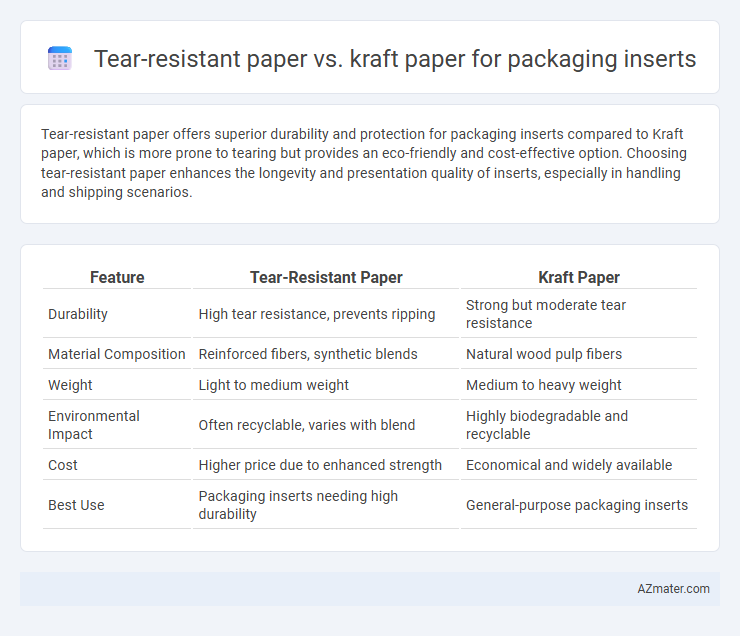Tear-resistant paper offers superior durability and protection for packaging inserts compared to Kraft paper, which is more prone to tearing but provides an eco-friendly and cost-effective option. Choosing tear-resistant paper enhances the longevity and presentation quality of inserts, especially in handling and shipping scenarios.
Table of Comparison
| Feature | Tear-Resistant Paper | Kraft Paper |
|---|---|---|
| Durability | High tear resistance, prevents ripping | Strong but moderate tear resistance |
| Material Composition | Reinforced fibers, synthetic blends | Natural wood pulp fibers |
| Weight | Light to medium weight | Medium to heavy weight |
| Environmental Impact | Often recyclable, varies with blend | Highly biodegradable and recyclable |
| Cost | Higher price due to enhanced strength | Economical and widely available |
| Best Use | Packaging inserts needing high durability | General-purpose packaging inserts |
Introduction to Tear-Resistant Paper and Kraft Paper
Tear-resistant paper offers enhanced durability and resistance to ripping, making it ideal for packaging inserts that require longevity and protection during handling and shipping. Kraft paper, known for its high strength and natural brown appearance, is widely used for packaging due to its recyclability and cost-effectiveness. Both materials provide reliable options for packaging inserts, with tear-resistant paper excelling in resilience and kraft paper favored for sustainability and strength.
Material Composition and Manufacturing Process
Tear-resistant paper for packaging inserts is typically made from chemically treated cellulose fibers that enhance durability and resistance to tearing, employing specialized pulping and refining techniques during manufacturing. Kraft paper is produced from wood pulp using the kraft process, which involves chemical pulping with sodium hydroxide and sodium sulfide to yield strong, coarse fibers ideal for robust packaging applications. While tear-resistant paper emphasizes enhanced fiber bonding and coating for durability, kraft paper relies on the natural strength of unbleached fibers and is often less chemically treated, resulting in a more eco-friendly but less tear-resistant material.
Strength and Durability Comparison
Tear-resistant paper offers superior strength and durability compared to Kraft paper, making it ideal for packaging inserts that require enhanced protection against tearing and environmental stress. Kraft paper, while strong and cost-effective, is more prone to ripping under heavy pressure or prolonged handling. For packaging inserts needing long-lasting integrity, tear-resistant paper provides a more reliable solution by maintaining structural stability throughout the shipping and handling process.
Flexibility and Handling Characteristics
Tear-resistant paper offers superior durability and resistance to ripping, making it ideal for packaging inserts that require secure protection during shipping and handling. Kraft paper, known for its natural brown color and high tensile strength, provides excellent flexibility and ease of folding, which enhances its suitability for intricate or customized packaging designs. The choice between tear-resistant and kraft paper depends largely on the required balance between durability and pliability for specific packaging applications.
Water and Chemical Resistance
Tear-resistant paper offers superior water and chemical resistance compared to Kraft paper, making it ideal for packaging inserts exposed to moisture or harsh environments. Its specialized coatings and fiber treatments prevent ink smudging and material degradation, ensuring durability during transit and storage. Kraft paper, while strong and eco-friendly, lacks the enhanced protective properties of tear-resistant paper, making it less suitable for packaging subject to water or chemical exposure.
Printability and Customization Options
Tear-resistant paper offers superior durability for packaging inserts, maintaining integrity during shipping while providing excellent printability with sharp image reproduction and vibrant color retention. Kraft paper is favored for its natural, eco-friendly appeal and sturdy texture, allowing customization through various printing techniques like flexography and letterpress, though it may have limitations in detailed color accuracy. Both materials enable branding flexibility, but tear-resistant paper excels in high-quality graphic customization, whereas Kraft paper suits rustic, earthy designs with substantial tactile presence.
Cost Implications for Businesses
Tear-resistant paper typically incurs higher costs due to specialized manufacturing processes that enhance durability, impacting overall packaging expenses for businesses. Kraft paper offers a more economical option with robust strength suitable for standard packaging inserts, making it a cost-effective choice for large-scale operations. Companies must balance durability needs against budget constraints, as investing in tear-resistant paper can reduce replacement frequency but increase initial material expenditure.
Environmental Impact and Sustainability
Tear-resistant paper typically contains synthetic fibers or coatings that reduce biodegradability, making it less environmentally friendly compared to kraft paper, which is made from natural wood pulp and is fully recyclable and biodegradable. Kraft paper has a lower carbon footprint due to its simpler production process and higher recyclability, contributing significantly to sustainable packaging solutions. Choosing kraft paper for packaging inserts aligns with eco-conscious practices by minimizing waste and supporting the circular economy.
Best Use Cases: Tear-Resistant vs. Kraft Paper
Tear-resistant paper excels in packaging inserts that require durability against rough handling and repeated folding, making it ideal for product manuals, warranties, and security tags. Kraft paper, known for its strength and eco-friendliness, is best suited for packaging inserts requiring a rustic or natural look, such as artisanal product tags or eco-conscious brand messaging. Choosing tear-resistant paper ensures longevity and high-performance protection, while Kraft paper emphasizes sustainability and a tactile, organic aesthetic.
Choosing the Right Paper for Packaging Inserts
Tear-resistant paper offers superior durability and protection for packaging inserts, making it ideal for products requiring long-lasting presentation and resistance to handling damage. Kraft paper, known for its eco-friendly and sturdy qualities, provides a natural, rustic look while maintaining moderate tear resistance suitable for lightweight or biodegradable packaging needs. Selecting the right paper depends on balancing durability requirements with sustainability goals and the overall brand aesthetic.

Infographic: Tear-resistant paper vs Kraft paper for Packaging insert
 azmater.com
azmater.com